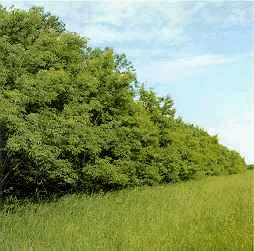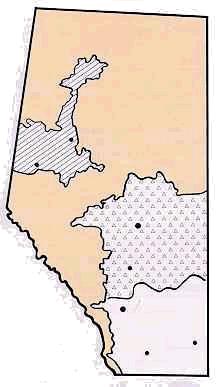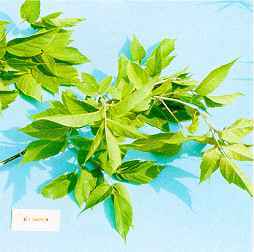| | Plant characteristics | Fall colour | Site preference | Hardiness | Uses | Problems | Diseases | Insects | Pruning

Scientific Name: Acer negundo L.
Plant Characteristics
Manitoba maple is a tall deciduous tree growing to a mature height of 7 to 12 m (23 to 40 ft), a spread of 11 m (36 ft), and an annual growing rate of 10 to 60 cm (4 to 24 in.). It is a good soil stabilizer. It is native to the eastern prairies.
Bark - Rough, greyish.
Flowers - Dioecious (male and female flowers on separate trees). Insignificant flowers appear slightly before the leaves.
Fruit - A samara consisting of two-winged seeds about 10 mm (0.4 in.) long (minus the wing), which stays on the tree during the early part of the winter.
Leaves - Opposite, pinnately compound with 3 to 5 leaflets, rarely 7 or 9. Each leaflet is ovate, coarsely serrate; bright green, lighter green below; 5 to 12 cm (2 to 5 in.) long, each with a short stalk. Terminal leaflet is often three-lobed. Propagated by seed.
Fall Colour
Leaves are red-brown.
Site Preference
Found along streams, in ravines, and wooded valleys on the prairies and parklands. It has wide soil adaptability, can survive drought conditions, and can withstand some shade.
Hardiness
Hardy - will survive under extreme climatic conditions.
.


Uses
Ornamental plantings, shelterbelts. In shelterbelt situations, Manitoba maple should be planted 2 to 4 m (6 to 13 ft) between trees in the row, and 5 to 8 m (17 to 26 ft) between rows.
Problems
Weak branch crotches make this species susceptible to wind damage.
Susceptible to pests, especially aphids and box elder beetles.
Short life.
Irregular growth habit.
Heavy seed set may result in weed problems in nearby gardens.
Can suffer top dieback during drought years.
Diseases
Susceptible to large leaf spot and powdery mildew.
Insects
Attracts aphids and drips honeydew.
Attracts box elder beetles.
Pruning
Pruning should be done as soon as leaves develop June to end of July as maples bleed. Prune to remove dead, diseased or broken branches.
.

Shelterbelts Varieties for Alberta provides information on a number of other trees and shrubs than may be suitable for shelterbelts.
Visit our website directory for the Reforestation Woodlot Listings. |
|